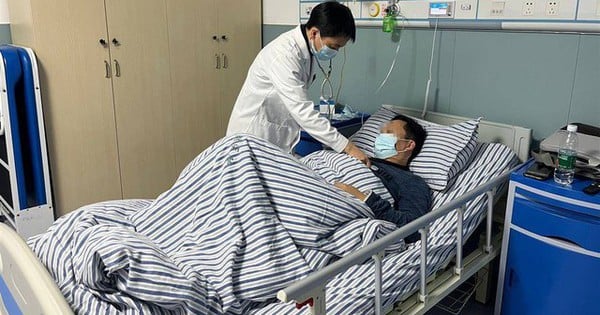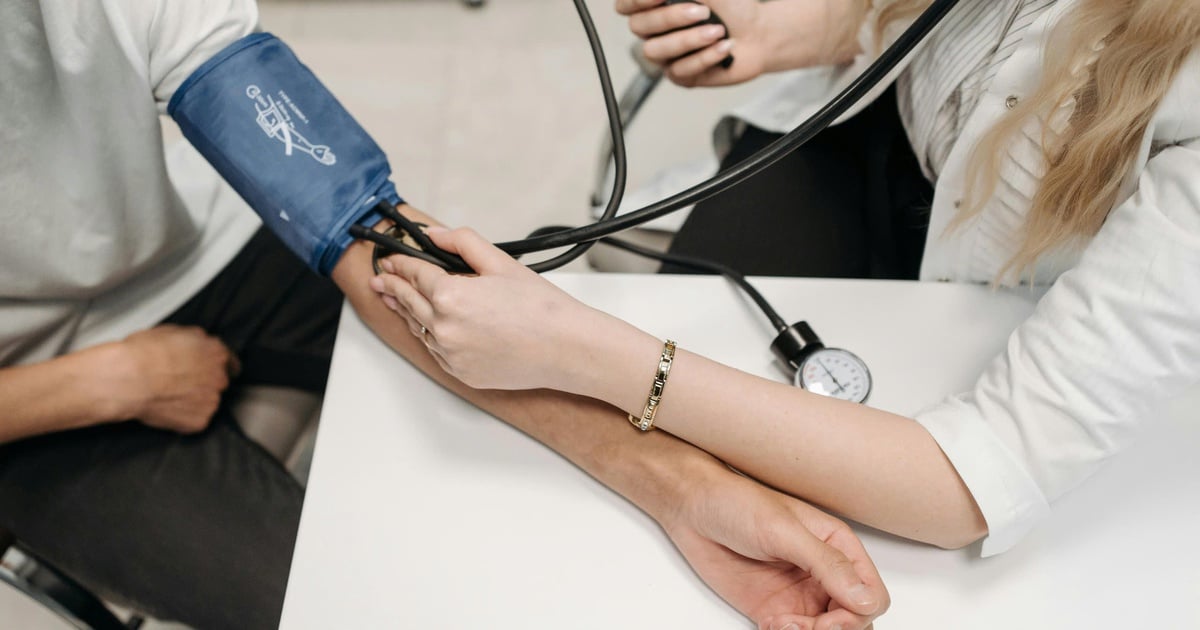The female patient was infected with parasites, had itchy rashes and hives for a year because of her habit of eating this favorite dish.
Sour meat - the culprit causing parasitic diseases
Female patient Bui Thi Huyen (58 years old, Hoa Binh) came to Medlatec Cau Giay General Clinic for examination in a state of itching with hives all over her body. After a health check, she was unexpectedly infected with roundworm larvae of dogs and cats. The cause of the infection was determined to be the habit of eating sour meat - a dish made from undercooked pork.
 |
| Illustration photo. |
For nearly a year now, Ms. Bui Thi Huyen has had itchy rashes and hives all over her body. At first, Ms. Huyen thought that she simply had itchy rashes due to allergies, so she tried some home remedies such as taking anti-itch medicine, applying warm compresses or bathing in herbal leaves...
After using these measures, the itching was relieved but often recurred, causing discomfort and anxiety, greatly affecting daily activities and quality of life.
Ms. Huyen had visited many places and received many treatments with many different types of medicine, but the rash and hives kept recurring. After that, introduced by an acquaintance, Ms. H. went to Medlatec Cau Giay General Clinic (at 2/82 Duy Tan, Cau Giay, Hanoi) for a health check-up, hoping to completely treat the rash and itching.
Taking a medical history, Ms. Huyen said that she had been in the habit of eating sour meat for many years. After a clinical examination and tests as prescribed by the doctor, Ms. H. was diagnosed with chronic urticaria caused by infection with roundworm larvae of dogs and cats.
Patients are prescribed outpatient medication, advised on food hygiene, nutrition, and appropriate lifestyle, and scheduled for a follow-up appointment.
Directly examining and treating this case, Associate Professor, Dr. Do Ngoc Anh, Parasitology expert, Medlatec Healthcare System, Lecturer specializing in Medical Mycology, Medical Micro-parasitology, Military Medical Academy affirmed that the treatment of parasitic diseases in general and chronic urticaria caused by roundworms in cats and dogs in particular requires patients to be persistent and comply with the prescribed regimen. Doctors should not only prescribe medication but also provide consultation so that patients have knowledge about the disease, feel secure and comply with the treatment regimen.
According to experts, sour meat is a traditional dish with the main ingredient being fresh pork marinated in rice bran for natural fermentation. The processing does not go through any heat treatment. This is a favorite dish of many people, especially in the summer, sour meat is indispensable on the drinking table.
However, the risk of parasitic infection from this favorite dish is very high. Similar to Ms. Huyen’s case, the proportion of people infected with parasites due to eating undercooked foods such as nem chua, blood pudding, salads, etc. accounts for a large proportion.
Associate Professor, Dr. Do Ngoc Anh said that clinical symptoms of infection with roundworm larvae in cats and dogs are often vague and non-specific. In some people, fatigue, allergies, itchy rash, hives, muscle aches, muscle pain, sluggishness, bloating, indigestion, etc. Roundworm larvae in cats and dogs can also parasitize and cause damage to the liver, lungs, central nervous system or eyes.
“Because the disease has no specific symptoms, it is easily overlooked. Therefore, people who show signs such as digestive disorders, itchy rash, hives, liver, lung, brain symptoms or have high risk factors should go to a medical facility for examination and testing to accurately diagnose the cause of the disease,” experts recommend.
In fact, the diagnosis of parasitic diseases in general and diseases caused by roundworm larvae in dogs and cats in particular still faces many difficulties and challenges.
It is not always possible to determine the exact location of the larvae in the body. Diagnosis and treatment require specialized knowledge, experience and understanding of the biological characteristics of the pathogen.
Therefore, people need to research and choose reputable medical facilities that meet professional capacity as well as equipped with modern testing equipment systems to accurately diagnose and effectively treat this disease.
In addition, to effectively prevent the risk of parasitic diseases, the most important measure is to comply with the principles of hygiene in eating and drinking, eating cooked food and drinking boiled water.
Experience from a missed gastric cancer case
Regarding the case of patient Pham Thi M. (1958, Vinh Phuc). She had dull pain in the epigastric region, pain when hungry and after eating for nearly 6 months before coming to Tam Anh General Hospital in Hanoi. She had insomnia and lost about 3 kg.
In September 2023, she had an endoscopy at a hospital and was diagnosed with gastritis, duodenal ulcer, and positive H.Pylori. She was treated with stomach medicine and it helped, but when she stopped taking the medicine, the pain returned.
At Tam Anh, Mrs. M's gastroscopy results showed an ulcerative lesion at the gastric cardia (about 5 cm in size) with mild atrophic gastritis (C1).
Infiltrative lesions spread to the surrounding surface, easily bleeding when touched. There are clear changes in the microvascular and surface microstructure. On Pathology, the patient was diagnosed with poorly differentiated adenocarcinoma.
Statistics show that in Vietnam, the rate of patients diagnosed with stomach cancer at a late stage is high, about 95% of patients are diagnosed at an advanced or metastatic stage. At this point, the patient is no longer able to undergo surgery, or even with surgery, the risk of recurrence is high within 5 years.
The 5-year survival rate is less than 20%. Doctor Vu Truong Khanh, Department of Gastroenterology, emphasized that patients are often accidentally discovered to have early stomach cancer during screening endoscopy when they are over 40 years old or have a stomach endoscopy due to other digestive diseases. When stomach cancer has symptoms, the disease is often in an advanced stage.
Gastric cancer usually progresses through a process, usually from atrophic gastritis, intestinal metaplasia, dysplasia. Patient M had a gastroscopy more than 5 months ago but the lesion was not detected, which is a typical case of missed disease.
According to Dr. Khanh, the basic reason for not seeing cancerous lesions is often due to poor preparation before endoscopy, with food, mucus, foam, etc. remaining in the stomach. Endoscopy techniques are not guaranteed when doctors do not have solid knowledge about H.Pylori infection on endoscopy, atrophy, intestinal dysplasia; observation is not in order, endoscopy time is too short, etc.
Biopsies in the wrong location, insufficient number of biopsy pieces; failure to connect clinicians with endoscopists, pathologists, etc. are also common causes leading to missed malignant lesions.
The doctor also shared more about the signs of H.Pylori infection on endoscopy such as: Red spots, diffuse redness, large mucosal folds, antral granulitis, milky white fluid, hyperplastic polyps, intestinal metaplasia, atrophy... How to distinguish H.Pylori infected stomach and other common stomach diseases...
Dr. Khanh concluded that, to avoid missing lesions like Ms. M's case, medical facilities and doctors need to prepare a clean stomach before endoscopy (fasting 6-8 hours before or fasting overnight, taking foam and mucus-dissolving medicine 15-20 minutes before endoscopy); gastrointestinal endoscopy doctors need to have knowledge of gastric cancer pathology to note risk signs on endoscopy, observe all locations, in order; and coordinate well between clinical doctors - endoscopists and pathologists.
People at high risk: over 40 years old, obese, family history of parents or siblings with stomach cancer, frequent smoking, alcohol abuse... should have regular endoscopy screening.
Early detection of gastric cancer, when malignant cells have not yet penetrated the submucosal layer, can result in a complete cure without having to remove the stomach or undergo chemotherapy. The risk of recurrence is low, and the 5-year survival rate is about 90%.
Saving the life of a patient bitten by a banded krait
At 11:00 p.m. on August 9, 2024, the Department of Surgery - Anesthesia - Resuscitation - Emergency and Anti-Poison, Van Don District Medical Center received patient Ly Dang T. (62 years old), residing in Quan Lan Commune, Van Don District, hospitalized with bleeding in the right ankle due to a snake bite.
It is known that on the night of August 9, 2024, while visiting the field, patient Ly Dang T. (62 years old) was entangled by a snake (banded krait) around his right ankle, then saw blood flowing from his right ankle.
The patient was immediately transferred by his family to Quan Lan Regional General Clinic for examination. At the Emergency Room, the patient was treated with intravenous fluids, SAT injections, anti-inflammatory injections, etc. The doctors determined that the patient's condition could be severe and at high risk. They immediately called the Van Don District Medical Center for consultation to transfer the patient to the Treatment Center immediately.
Immediately after receiving the information at night, the Emergency Team of the Examination Department, Van Don District Medical Center sent an emergency team to pick up the patient for treatment.
After more than 2 hours of continuous boating at night, at around 1:30 a.m. on August 10, 2024, the emergency team took the patient to the Department of Surgery - Anesthesia, Resuscitation - Emergency and Anti-Poison, Van Don District Medical Center for treatment.
Here, the patient is immediately examined by doctors and nurses who clean the wound, give IV fluids, reduce pain, reduce inflammation, and perform basic tests to assess the patient's general condition.
After 1 day of monitoring, care and treatment, the patient's health has stabilized. It is expected that the patient can be discharged next week.
Dr. Nguyen Khac Manh, Head of the Department of Surgery - Anesthesia - Resuscitation - Emergency and Anti-Poison said that the patient Ly Dang T. (62 years old) was fortunate to be brought to the hospital early to treat the wound caused by a venomous snake bite in time, so he was able to fully recover, without affecting his life.
On the contrary, the patient may die quickly due to respiratory muscle paralysis or be left with permanent paralysis and coma due to prolonged lack of oxygen to the brain. Therefore, when bitten by a snake or in case of being bitten by a snake, people need to take the victim to a medical facility for emergency treatment and timely treatment to avoid loss of life.
Doctors recommend that to prevent snake bites, you need to know the types of snakes in the area and know the areas where snakes like to live or hide.
Wear boots, high-top shoes and long pants, especially at night, and a wide-brimmed hat if walking in the woods or in grassy areas. Stay as far away from snakes as possible, as dead snakes can still bite. Do not catch, chase or corner snakes in enclosed areas.
Do not live near places where snakes like to live or visit, such as piles of rubble, garbage, or places where family animals are kept.
To avoid sea snake bites, people should not catch snakes in nets or fishing lines. Use a flashlight if in the dark or at night.
Source: https://baodautu.vn/tin-moi-y-te-ngay-118-nguy-hiem-thoi-quen-an-thit-tai-song-d222151.html



![[Photo] "Beauties" participate in the parade rehearsal at Bien Hoa airport](https://vstatic.vietnam.vn/vietnam/resource/IMAGE/2025/4/11/155502af3384431e918de0e2e585d13a)



![[Photo] Looking back at the impressive moments of the Vietnamese rescue team in Myanmar](https://vstatic.vietnam.vn/vietnam/resource/IMAGE/2025/4/11/5623ca902a934e19b604c718265249d0)






















![[Photo] Summary of parade practice in preparation for the April 30th celebration](https://vstatic.vietnam.vn/vietnam/resource/IMAGE/2025/4/11/78cfee0f2cc045b387ff1a4362b5950f)


























































Comment (0)